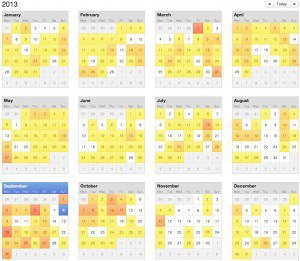Did you know that 2013 is the first year since 1987 not to have a repeating digit?
This is a great investigation to set your class.
-
Using the digits 2 0 1 3 write all the 4-digit number that you can make without repeating a digit.
-
What is the largest number you can make with no digits being repeated?
-
What is the largest number you can make if your number had 2 repeating digits? ….3 repeating digits? …. 4 repeating digits?
-
What is the difference between these three numbers?
Helpful hint: Talk about the zero. A number cannot usually begin with zero, eg 0132 would have the value of 132 as there are no thousands. Explain that sometimes the zero is used, especially when writing dates. 08/09/2013 is the 8th September 2013. It shows that a digit has not been missed and computers need dates entered as 2-digits.
Calculate the day of the week for any date
Lots of maths learning a fun skill of naming the day for any date
A Special date with consecutive square numbers
4th September 2016 was a square day! 4.9.16. Explore other square days.
Consecutive dates - an investigation adding 3 consecutive numbers
11.12.13 was a special date with consecutive numbers.
Palindromic dates - how many can you find?
21.11.12 or 31.1.13 - will there be any palindromic dates in the next year?
All about 15 maths activities for 15.12.15
These ideas can be adapted... 16 minutes of maths for 16th of September, October, November or December 2016.
This includes finding Fibonacci numbers in nature, exploring patterns and rules in number sequences, sunflowers and cones.



